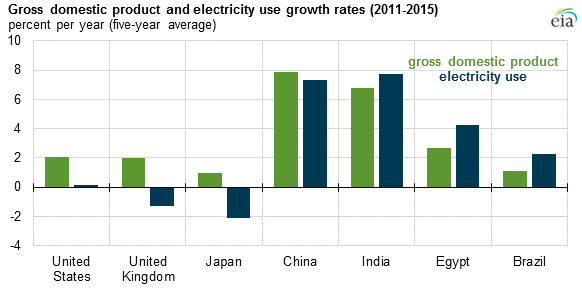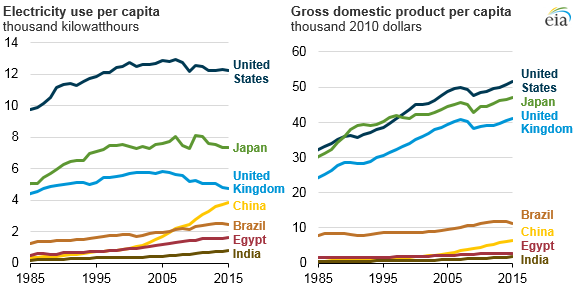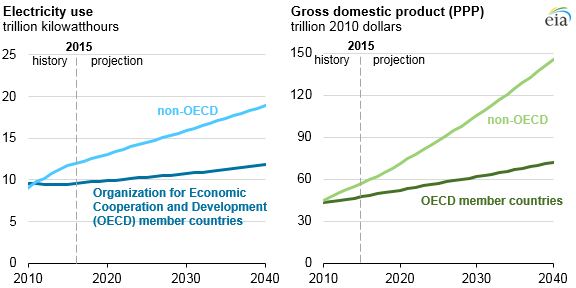GDP growth rates historically have been tied to electricity usage due to population growth and the need to generate more goods and services to serve the growing populations, but traditional metrics are changing.
This relationship between energy usage and economic growth has changed in recent times for several reasons, according to a new study by the EIA. The EIA said that reasons include the countries’ relative levels of development, electrification, economic makeup, and income levels.

The shift from manufacturing to service economies reduces electricity needs
Developed OECD member countries have been shifting from manufacturing economies towards service economies. Service economies usually use less electricity than economies with highly active manufacturing industries. Commercial services are generally less energy-intensive compared to manufacturing, according to EIA data. Additionally the U.S., UK, and Japan have been shifting towards advanced manufacturing, which uses energy efficient technology.
“As more economic activity shifts from lower-skilled manufacturing to services and higher-skilled advanced manufacturing, additional economic activity can be generated without requiring as much electricity use,” the EIA said.

Non-OECD member countries such as Brazil, Egypt, China, and India have growing economies powered by large or increasing manufacturing sectors. These countries use less efficient technologies and have lower-skilled labor compared to developed OECD member countries, resulting in more energy usage to produce goods and services.
Among OECD member countries in recent years, national electricity usage has remained generally flat, but the EIA projects modest growth in usage over time. In 2011 non-OECD member countries used more electricity than OECD member countries. The International Energy Outlook 2017 (IEO2017) estimates that non-OECD member countries will continue to use more electricity, but the amount will depend on how fast non-member economies grow and the methods used to create economic growth.

Note: Gross domestic product comparisons based on purchasing power parity (PPP).
“For both groups, IEO2017 projects electricity growth to remain lower than the rate of economic growth. In the IEO2017 Reference case, among OECD member countries, gross domestic product (GDP) increases by 1.7% per year, and electricity use increases by 0.9% per year between 2015 and 2040. In non-OECD countries, GDP increases by 3.8% per year, and electricity use increases by 2.0% per year over the same period,” said the EIA.
OECD reports slower member economic growth in Q3
The OECD reported today that OECD GDP growth slowed to 0.6% in Q3 2017.
Quarterly growth of real gross domestic product (GDP) in the OECD area slowed to 0.6% in the third quarter of 2017, compared with 0.8% in the previous quarter, according to provisional estimates.
Among the Major Seven economies, Q3 GDP growth appeared as follows:
- Japan slowed to 0.3%, compared sequentially with 0.6% in the previous quarter;
- United States slowed (to 0.7%);
- France slowed to 0.5%;
- Growth picked up in Germany (to 0.8%, compared with 0.6%);
- Italy went to 0.5%, up from 0.3%;
- United Kingdom rose to 0.4%, up from 0.3%).
- In the European Union and the euro area, growth slowed marginally to 0.6% (down from 0.7%).
Year-on-year numbers
Year-on-year GDP growth for the OECD area accelerated to 2.6% in the third quarter of 2017, compared with 2.4% in the previous quarter, the organization reported. The United Kingdom recorded the slowest growth (1.5%) among the Major Seven economies, slipping from second highest in mid-2016.

Current OECD membership
- Australia
- Austria
- Belgium
- Canada
- Chile
- Czech Republic
- Denmark
- Estonia
- Finland
- France
- Germany
- Greece
- Hungary
- Iceland
- Ireland
- Israël
- Italy
- Japan
- Korea
- Latvia
- Luxembourg
- Mexico
- Netherlands
- New Zealand
- Norway
- Poland
- Portugal
- Slovak Republic
- Slovenia
- Spain
- Sweden
- Switzerland
- Turkey
- United Kingdom
- United States




